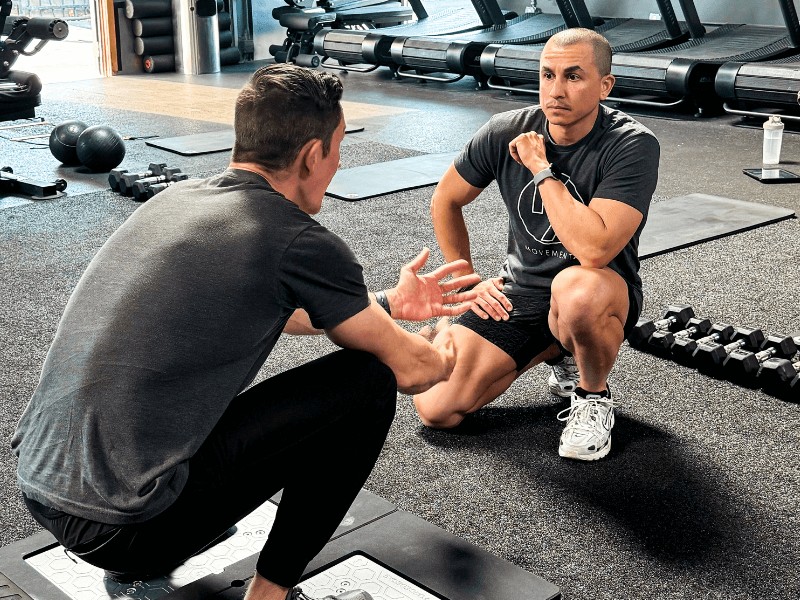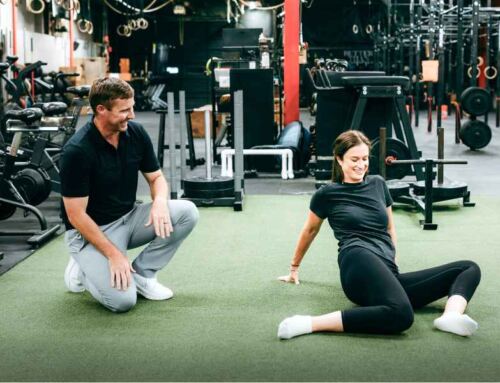Maximizing Recovery Post-ACL Surgery: Essential Steps for Early Rehab
Each year, Anterior Cruciate Ligament (ACL) ruptures impact over 200,000 people in the United States alone, with some estimates being higher. Of those affected, only about 55% return to a competitive level of sport. While men experience a higher overall incidence of ACL injuries due to participation in competitive sports, young women face a significantly higher relative risk—2-8x greater than men. This disparity is likely attributed to a multitude of factors such as: relative training age, nutritional habits, anatomical differences, demands of sport, overall strength, etc. which should lend credence to the complexity of this type of injury.
An ACL rupture not only impairs stability, it also severely affects one’s movement confidence, ability to jump, change directions, pivot, and can expedite the onset of degenerative joint issues. This injury can be profoundly debilitating, altering the course of an athlete’s career and quality of life.
In response to the prevalent issue of substandard care and the disappointing recovery outcomes we see today, it is critical to discuss the ACL and current best practice procedures. Let’s explore the ACL, the common mechanism of injury, and introduce practice steps designed to optimize recovery potential during the crucial early stages of rehabilitation.
Common Mechanisms of ACL Injury
The anterior cruciate ligament is an important stabilizing ligament for the knee which prevents excessive anterior translation (forward movement) of the tibia (shin) on the femur (thigh bone), and excessive rotatory movement between the tibia and femur. This ligament is often injured during non-contact movements in sport such as decelerating into plant-foot and pivoting/changing directions, but otherwise during traumatic accidents. The most common position for the knee to be in when this injury occurs is between 20-30 degrees of knee flexion while pivoting during a high rate of velocity change with a “stiffened knee”.
Following an ACL tear or rupture, an ACL Reconstruction (ACLR) is a common surgical procedure used to restore knee stability and function. There are several ligament graft options available, all with their own advantages and disadvantages, but typically there are four graft types used to replace the torn ligament: Bone-Patellar Tendon-Bone (BPTB), Hamstring, Quad Tendon, and Allograft (cadaver). The following steps for early rehab can and should be performed regardless of which graft type is used.

The Importance of Immediate Physical Therapy After ACL Injury
The question of when to initiate rehabilitation post-surgery is often muddled by surgical precautions, poor understanding of physiological changes post-surgery, reliance on outdated protocols, varying levels of patient ability, and restricted access to therapy services. It is crucial to address this confusion directly: Start physical therapy within the first 5 days of surgery, but starting PT for your ACL immediately after surgery—specifically on Day 1 Post-Operatively—is immensely beneficial.
Early intervention is key to:
- Reduce Swelling: Promptly addressing swelling can significantly impact the healing process, overall comfort, reduce arthrogenic muscle inhibition (AMI) and improve the ability to activate the quad.
- Alleviate Pain: Early therapeutic interventions can help manage pain, making the recovery process more bearable, while also providing increases to quad activation.
- Restore Full Knee Extension: Regaining full/symmetrical knee extension is critical for weight bearing, normalized walking, quad activation.
- Regain Quad Activation: Early activation of the quadriceps is essential for knee stability and strength, and lays the foundation for load tolerance during impact and deceleration.
The Quadricep Muscle and Its Importance
Simply stated, it’s the quad until it’s not. The cascade of injury, surgery, pain, swelling at the joint, and altered signaling leads to arthrogenic muscle inhibition (AMI) which is a neural inhibition that impedes the quads ability to voluntarily contract. Pain can negatively impact range of motion (ROM), exercise tolerance, general strength, force production, confidence, and rest/recovery. Decreased extension ROM can impair walking ability and reduce quad activation leading to long term strength deficits.
Altered signaling between the brain, the spinal cord, and the quad results in an inability to recruit a large portion of motor units in the quad immediately following surgery. As a result, this can reduce the size of quad, strength of quad, and impact overall joint health. Importantly, the quad is responsible for counteracting knee flexion moments which influences how we manage external forces in daily life and sports activities.

Plainly, if you do not have sufficient quad strength, you will need to compensate via excess range of motion at other joints and/or cause strain to other muscles to alleviate stress at the knee which can lead to re-injury. The deficits that occur as a result of injury/surgery not only negatively impact the injured limb, but also the unaffected limb which lead to long term impairments and poor outcomes.
Below is an important list of interventions and parameters to address each of the aforementioned items in the early stages of physical therapy after your ACL surgery.
Initial Steps in Effective ACL Rehab
1. ICE
- Surround entire knee joint for 20-30 min prior to exercise
- Before exercise, ice has been shown to increase quad activation and strength
2. TENS Unit
- Place pads around knee joint for 20-30 min on the High Frequency Setting
- Before and during exercise TENS has been shown to increase quad activation
3. Quad Squeeze w/ Strap Assistance
- Achieving a quad squeeze w/ full knee extension and the heel of your foot “popping off” the ground or table is a major milestone which you should attempt to achieve within the first two weeks of rehab
- Start with a strap to assist with “heel pop” and slowly progress to attempting heel pop on your own -> unassisted.
- Use NMES unit to assist in quad contraction (can be used 4-12 weeks post-op)
- Aim for a minimum of 100 reps throughout the day with progression of holds 3-5 seconds to tolerance
4. Compression and Elevation
- Elevate heel above the level of your heart
- Apply compression to knee joint as any swelling can impact the quads ability to contract
- Avoid resting the knee in bent position and attempt to prop heel without support underneath the knee
5. Knee Extension with Low Load and Long Duration Stretching
- Achieve full knee extension to the same degree as your uninvolved leg
- Aim to complete this + compression/elevation for at least 60 min daily
- Session can be broken up to tolerance with goal being to increase time
6. Patellar Mobility
- Push knee cap Up, Down and Side to Side
- 2-4 sets of 20 reps per direction.
- Can be done with quad squeezes performed in-between sets to improve patellar tracking
- Patients will often experience patellar stiffness which can impact terminal knee extension if knee cap cannot glide and sit into typical groove during knee bending and extending
Overcoming Common ACL Rehab Challenges
Aside from overcoming the physiological and mental hardships in the early stages of rehab, there are several other challenges to expect early on. Improving time and communication constraints are vital to the delivery of quality care. This process requires dedicated attention to the patient, their family, the surgical team, the rehabilitation team, school/work/coaches, etc. especially with regards to cohesive implementation of the rehab plan.
This will ensure that important actions are carried out such as surgical site inspection, education for assistive device use, brace fitting and monitoring, discussions surrounding limitations and progressions, info for at-home use of TENS/NMES unit, exercise interventions, rehab planning per the individual, and building a healthy relationship between the patient and rehab team.
Another common challenge with ACL rehab is the poor implementation of a time based protocol for return to sport (typically seen as 9 months). While it is easy to follow a timeline based structure, it is more important to follow criteria based protocols to address a multitude of factors such as biological tissue healing, psychological readiness, objective strength, return to sport testing, activity-specific demands, and concomitant injuries. Without quality physical and mental preparation, the risk of a second ACL injury occurs in up to 40% of young athletes, including to the contralateral knee.
Moreover, between 50-90% of ACL injuries progress to post-traumatic osteoarthritis, at a rate of 6x higher than in uninjured individuals. Out-of-network physical therapy with MovementX largely addresses these challenges by offering advantages over traditional rehab methods. It provides: increased availability, extended treatment sessions, 1-on-1 personalized care, fewer barriers to best practices (objective testing, education, strength and conditioning, return to sport training), enhanced educational opportunities, and uninterrupted care free from insurance constraints.

Conclusion: Navigating Early Rehab
ACL rehab is incredibly complex and requires time, guidance, and healthy communication. While it may seem daunting, I believe it is important to mitigate as many foreseeable challenges as possible. Rehab is rarely linear, but we have the resources to objectively guide care to improve patient outcomes and their quality of life. If you or someone you know would benefit from a physical therapy session with MovementX, sign up now or give us a call and we’ll ensure you’re set on the best possible path to recovery.
References
- Arundale AJH, Silvers-Granelli HJ, Myklebust G. ACL injury prevention: Where have we come from and where are we going? J Orthop Res. 2022; 40: 43–54. https://doi.org/10.1002/jor.25058
- Chia L, De Oliveira Silva D, Whalan M, McKay MJ, Sullivan J, Fuller CW, Pappas E. Non-contact Anterior Cruciate Ligament Injury Epidemiology in Team-Ball Sports: A Systematic Review with Meta-analysis by Sex, Age, Sport, Participation Level, and Exposure Type. Sports Med. 2022 Oct;52(10):2447-2467. doi: 10.1007/s40279-022-01697-w. Epub 2022 May 27. PMID: 35622227; PMCID: PMC9136558.
- Norte G, Rush J, Sherman D. Arthrogenic Muscle Inhibition: Best Evidence, Mechanisms, and Theory for Treating the Unseen in Clinical Rehabilitation. J Sport Rehabil. 2021 Dec 9;31(6):717-735. doi: 10.1123/jsr.2021-0139. PMID: 34883466.
- Evans J, Mabrouk A, Nielson Jl. Anterior Cruciate Ligament Knee Injury. [Updated 2023 Nov 17]. In: StatPearls [Internet]. Treasure Island (FL): StatPearls Publishing; 2024 Jan-. Available from: https://www.ncbi.nlm.nih.gov/books/NBK499848/
- Whittaker JL, Culvenor AG, Juhl CB, et alOPTIKNEE 2022: consensus recommendations to optimise knee health after traumatic knee injury to prevent osteoarthritisBritish Journal of Sports Medicine 2022;56:1393-1405.
- Waldron K, Brown M, Calderon A, Feldman M. Anterior Cruciate Ligament Rehabilitation and Return to Sport: How Fast Is Too Fast? Arthrosc Sports Med Rehabil. 2022 Jan 28;4(1):e175-e179. doi: 10.1016/j.asmr.2021.10.027. PMID: 35141549; PMCID: PMC8811519.
- Koga H, Nakamae A, Shima Y, et al. Mechanisms for Noncontact Anterior Cruciate Ligament Injuries: Knee Joint Kinematics in 10 Injury Situations from Female Team Handball and Basketball. The American Journal of Sports Medicine. 2010;38(11):2218-2225. doi:10.1177/0363546510373570







